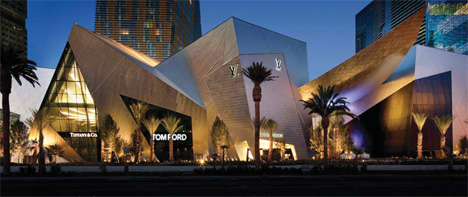Malls world
The latest wave of urban shopping centres are glamorous temples to consumerism, ignoring any hint of recession with their strong branding and environments as chic as any of their retail tenants. Dominic Lutyens talks shop with designers and developers

To many, the term ’shopping centre’ conjures up an image of a hermetically sealed parallel universe, vacuum-packed within baldly functionalist, utterly soulless architecture.
And yet a new generation of shopping centres is challenging the stereotype: Westfield in London’s Shepherd’s Bush has considerably upped the ante design-wise, and its sister retail destination, Westfield Stratford City in east London, looks set to do the same when it opens in September.
Then there’s the self-consciously glamorous One New Change near St Paul’s Cathedral in the City of London, designed by Jean Nouvel in collaboration with architect Siddell Gibson. This building foregrounds contemporary design, with its crystalline glass structure in shades of beige, grey and – Nouvel’s trademark colour – Chinese lacquer red.
Further afield, mall design is also becoming increasingly sophisticated. Witness Daniel Libeskind’s Crystals at Citycenter mall in Las Vegas, and Budapest’s new Corvin mall, whose interiors and wayfinding were created by London consultancy Air Design.
According to Air Design chief executive Alan Robertson, mall operators and developers are motivated by ’the idea that malls are now more than just a collection of shops held together by the mall environment, but retail destinations in their own right’.
Westfield has an in-house design team whose remit includes ensuring that retailers comply with its design guidelines, but it is also encouraging experimentation. For the Stratford site, it has collaborated with hip architects Softroom and Angus Pond Architects. The former has designed a 150m-long space incorporating retailers and restaurants featuring a ’shabby chic’ scheme that juxtaposes raw, exposed steel columns and polished Carrara marble.
The public areas of malls are tending to become more informal, with flexible, modular interiors that can change to keep people interested. Ab Rogers and Universal Design Studio are creating kiosks – which could be used as champagne bars or ice-cream stalls – for Westfield’s Stratford site. ’Static theming is out,’ asserts Michelle Du-Prât, insights director at design consultancy Household, which designed an Oasis store in Westfield, Shepherd’s Bush. ’Manchester Trafford Centre’s food court, say, has a very fixed New Orleans theme which makes it difficult for the space to change function.’
Wayfinding is also being refined. You might suspect that malls have a vested interest in having unclear signage so shoppers wander aimlessly and spend more, but experts think otherwise. ’We know that not finding your way around is a very negative experience – especially when you need to go to the loo,’ says Robertson. ’Not having a first-class navigation system smacks of not caring about shoppers. State-of-the-art wayfinding now ideally encompasses signage posts with touch-screen, dualor triple-language directories and ultra-legible typefaces.’
When it comes to branded fascia style, how much freedom shopping centres allow retailers varies. At One New Change, the (pub-like) shop signs are standardised in terms of size and shape. The effect is tidy but bland. Conversely, retailers at Westfield in Shepherd’s Bush were invited ’to create exceptional fascias’, says Du-Prât. ’That said,’ she continues, ’As shopping centres become stronger brands, their design guidelines are getting stricter.’
Paradoxically, while clear wayfinding is considered vital, so too are ways of inducing customers to hang out longer. ’Corvin,’ says Robertson, ’achieves this with its “home from home” interiors: wallpaper, luxurious toilets, very comfortable seating in the food court and areas where kids can chill out watching films projected onto the ceiling.’ Almost infinitely programmable LED lighting – to vary atmospheres – is another increasingly popular design feature.
Even so, some believe malls could afford to be more adventurous. ’There’s a missed opportunity for mall developers to create innovative zones where retailers can be more experimental,’ believes Rachel Bowyer, associate director of Brinkworth, which created several store interiors at One New Change and is designing shops for Westfield in Stratford. ’But I think this is the direction malls will move in.’
-
Post a comment




